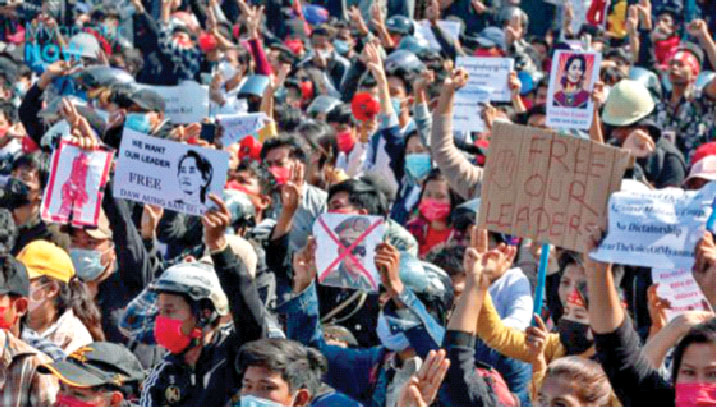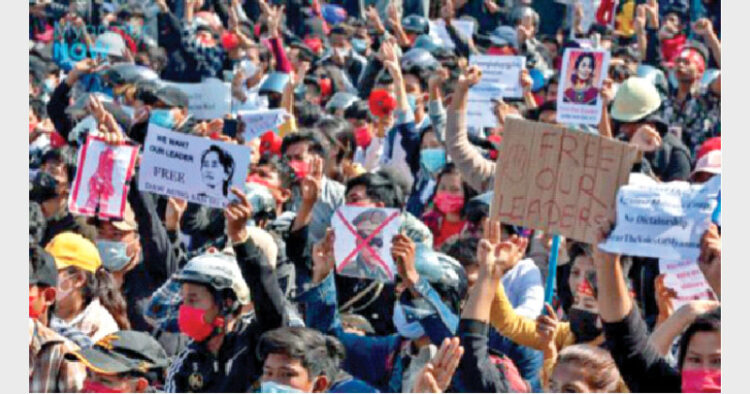Military takeover over of power in Myanmar is a setback to India’s Act East Policy. However, it is essential for India to continue the engagement with the military leadership, so as not to leave the field open for China, and to expedite pending projects
–Dr Shristi Pukhrem

Protests erupted after the military staged a coup in Myanmar
In the early hours of February 1, 2021, Myanmar’s dalliance with electoral democracy came to an abrupt end, as the Tatmadaw (Armed Forces of Myanmar) assumed command of the country for one year. It detained State Counsellor Aung San Suu Kyi, the de facto leader of National League of Democracy (NLD) government as well as President Win Myint, on charges of electoral fraud. NLD had just swept the elections held in November 2020. Along with NLD leaders and chief ministers, many other journalists, activists, who were critical of the military; were incarcerated. The coup d’état of 2021, the third in Myanmar’s political history — the first two being in 1962 and 1988– could derail Myanmar’s economic growth. This coup has not only altered Myanmar’s political landscape, but also has the potential to destabilise the geopolitics of the South and Southeast Asian region. Historically, Myanmar has held a deeply isolationist streak in its foreign policy. But since the late 1980s, it became increasingly dependent on China in the face of intense international criticism. This began to change in the first decade of the century, as the country progressed towards democracy.
The existing government structure was not entirely democratic, as the 2008 Constitution guarantees the military 25 per cent seats in the parliament and does not permit constitutional amendments without a 75 per cent majority. In addition, Tatmadaw controlled three crucial ministries. Consequently, the elected representatives were not free to decide domestic or foreign policy on their own. The coup will undoubtedly slow down the pace of foreign investments. In case the crisis prolongs beyond the initial one year promised by the Tatmadaw, there is a danger that Myanmar could go back into the isolationist mode of Ne Win era, with only China, and probably India, willing to engage with it.
The military may be forced to deploy itself in Myanmar’s urban centres, which are likely to be the springboards for protests. This could lead to the resurgence of domestic insurgencies in Myanmar, as Tatmadaw will need to thin its presence in the peripheries, for it to be deployed in urban centres. Many insurgent groups that had signed the ceasefire agreement with the government have already voiced their opposition to the military takeover. In any case, over the last two years, clashes between the military and Arakan Army (AA), an insurgent group based in the country’s west, have left thousands of combatants and civilians dead, and hundreds of thousands displaced in Rakhine and Chin states. To further aggravate matters, Rohingyas, who have been displaced from their homes are rapidly getting radicalised by Islamic State and Al Qaeda.
The government’s decision last March to designate the AA a terrorist outfit has made prospects for peace in the area quite remote. A decision by Myanmar’s Election Commission to cancel voting across much of the Rakhine State had further compounded the problem. Interestingly, just after the vote, both the AA and the Tatmadaw, issued coordinated statements calling for elections in areas where voting had been cancelled. More significantly, the guns have since fallen silent in a fragile but significant cease-fire. This informal truce has now held for more than two months, allowing tens of thousands of displaced civilians to return home. Meanwhile, the warring parties have met three times for discussions on potential elections and further steps to end the conflict. This military interregnum, ironically could provide a silver lining as far as resolution of conflict in Rakhine State is concerned.
While India should try to nudge the regime on the path of democracy, this timeframe should be utilised to expedite the projects of physical connectivity
Many foreign governments and international institutions have criticised the military’s actions. US President Joe Biden stated that the US ‘removed sanctions on Burma…based on progress toward democracy’ and that ‘the reversal of that progress will necessitate an immediate review’. UK Prime Minister Boris Johnson called for the Tatmadaw to ‘respect the rule of law and human rights, and release those unlawfully detained’. The EU, its member states and UN Secretary-General Antonio Guterres made similar criticisms. China’s reaction has been largely predictable. The foreign ministry spokesperson ‘noted’ the situation in Myanmar and hoped that ‘all parties in Myanmar will properly handle their differences under the constitution and legal framework to maintain political and social stability’. As Chinese foreign ministry spokesperson Wang Wenbin noted, China is a friendly neighbour to Myanmar. The carefully cultivated ties with Myanmar’s government have further facilitated China’s deepening relationship with another ASEAN member state, offering material support and cover from international pressure over the situation in the Rakhine State within the UN Security Council. President Xi Jinping’s first overseas trip in 2020 was to Myanmar and China is reportedly the second-largest investor in Myanmar after Singapore.
Implications for India
India’s Act East Policy (AEP) might at best face a temporary setback. Although Indian military has excellent relations with the Tatmadaw and the government, despite its proclivities for the establishment of a democratic dispensation, will continue to engage with the military regime, the international community may shun Myanmar, which may affect many multilateral projects planned in Myanmar or through Myanmar. Much of AEP stands reliant on Myanmar providing further connectivity to the South East Asian neighbourhood. In case instability increases in Myanmar on account of ethnic insurgencies, many of these initiatives may be inordinately delayed or may not remain financially viable. On the positive side, the Tatmadaw’s capability in expeditiously resolving pending bottlenecks is likely to be far better than the democratic regime.
India in its official statement has noted the developments in Myanmar with deep concern and stated that “India has always been steadfast in its support to the process of democratic transition in Myanmar. We believe that the rule of law and the democratic process must be upheld.” As a democracy, the statement is on the expected lines, but it would be premature to visualise any drastic alterations in India’s engagement with Myanmar. It is essential to continue the engagement, so as not to leave the field open for China. It is significant to note that the Tatmadaw was not very happy with the recent signs of bonhomie between China and NLD government.
While India should try to nudge the regime on the path of democracy, this timeframe should be utilised to expedite the projects of physical connectivity. The Trilateral Highway or India-Myanmar-Thailand (IMT) Project could be expedited and the Tatmadaw could be requested to revert back to driving on the Left as that could facilitate seamless movement from Kathmandu to Singapore through India, Bangladesh, Thailand and Malaysia, besides Myanmar, as all of them drive on the left. The recent visit of India’s Foreign Secretary and the Chief of Army Staff to Myanmar, in October 2020, highlighted the significance of Myanmar to India and the utilisation of military to spearhead diplomatic engagements with countries with military hierarchies. It is hoped that the government will utilise this channel to engage with the current regime, while maintaining its existing lines of communications with NLD leadership.
(The writer is a Senior Research Fellow at India Foundation)














Comments